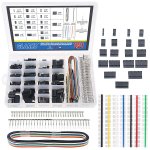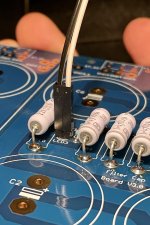If anyone is familiar with the 'pins' on computer motherboards for attaching status LEDs, power/reset, or other elements, I am trying to recreate that on a PCB. Looking on Mouser, there are so many options I cannot find what I need. Also want to make sure it is something designed to be soldered, if possible (the short pins talked about below).
Instead of soldering the wires directly to the PCB (in this case, where a power LED would normally attach), I want to solder pins, which would then attach to wires terminated with a sleeve (to slip over the pins), then the other end of the wire would have the LED attached.
Because I know you will ask/are curious...because the LEDs are getting permanently glued into the face plate of the amp, and I want to be able to unplug the wires so I can remove the PCB, otherwise it is a one way trip.
Thanks!!!
The below parts are very close, and might even work, however would like to learn so I can buy my own later. These are from an Arduino kit. On the far-right, looking for something like that (3mm spaced pair, or individual ones) that I can solder to the PCB (the short pins) then have the exposed long pins. The other part would be some sort of sleeve or connector I can attach to some cable (the long black cubes shown, but it could also be exposed metal, as long as it fits properly over the long pins). Then at the other end of the black and white cable I would solder the LED to that.

Instead of soldering the wires directly to the PCB (in this case, where a power LED would normally attach), I want to solder pins, which would then attach to wires terminated with a sleeve (to slip over the pins), then the other end of the wire would have the LED attached.
Because I know you will ask/are curious...because the LEDs are getting permanently glued into the face plate of the amp, and I want to be able to unplug the wires so I can remove the PCB, otherwise it is a one way trip.
Thanks!!!
The below parts are very close, and might even work, however would like to learn so I can buy my own later. These are from an Arduino kit. On the far-right, looking for something like that (3mm spaced pair, or individual ones) that I can solder to the PCB (the short pins) then have the exposed long pins. The other part would be some sort of sleeve or connector I can attach to some cable (the long black cubes shown, but it could also be exposed metal, as long as it fits properly over the long pins). Then at the other end of the black and white cable I would solder the LED to that.
@canonken , what you have looks like a great solution to me.
Mouser and Digi-Key have pretty good tools for narrowing down the search.
For the PCB side, you could search for "headers" and "male pins". I got it down to 29 options when selecting "1 row", "2 positions", and "Normally Stocking". For example, this part has a shell around the base. The page has a link to the mating piece for the wire side.
For the wire side, select "Rectangular Connectors - Housings", "contact type = female sockets"
Kind regards,
Drew
Mouser and Digi-Key have pretty good tools for narrowing down the search.
For the PCB side, you could search for "headers" and "male pins". I got it down to 29 options when selecting "1 row", "2 positions", and "Normally Stocking". For example, this part has a shell around the base. The page has a link to the mating piece for the wire side.
For the wire side, select "Rectangular Connectors - Housings", "contact type = female sockets"
Kind regards,
Drew
also, the spacing for those pins is 0.1 inches or 2.5 mm. It is a very common connector pin spacing.
I often use something like this to attach a remote LED or pushbutton to some 0.1"/2.54mm spacing PCB headers (as shown in you post). These are sold as power connectors for radio control receivers:
https://www.componentshop.co.uk/futaba-2-wire-22awg-lead-male.html
https://www.componentshop.co.uk/futaba-2-wire-22awg-lead-male.html
I was going to say that 0.100"/2.54mm is a very common spacing (pitch). 3mm not so much. You could look at the Molex KK 2.54mm spaced headers/receptacles, as these are quite common. The one shown above used by Futaba looks nice as well, but better to find out who makes the connector itself.
Thanks!
I had better luck on Digikey with the images (know I need to check the spec sheet before ordering though). Immediately found this which is exactly the style I want (or similar, but this is the right category).
https://www.digikey.com/en/products/detail/amphenol-icc-fci/77311-118-02LF/1523689
Still having trouble finding the wire-side ones. This is what I get when I pop the plastic cap off. Guessing this might be more of a 'kit' (you get both pieces), having trouble finding this. I am in the right section (easier finding them on Mouser!): https://www.mouser.com/c/connectors/terminals/?product=Wire to Board Terminals&instock=y - just not sure exactly the right ones size-wise
This is what I need for the wire:

I had better luck on Digikey with the images (know I need to check the spec sheet before ordering though). Immediately found this which is exactly the style I want (or similar, but this is the right category).
https://www.digikey.com/en/products/detail/amphenol-icc-fci/77311-118-02LF/1523689
Still having trouble finding the wire-side ones. This is what I get when I pop the plastic cap off. Guessing this might be more of a 'kit' (you get both pieces), having trouble finding this. I am in the right section (easier finding them on Mouser!): https://www.mouser.com/c/connectors/terminals/?product=Wire to Board Terminals&instock=y - just not sure exactly the right ones size-wise
This is what I need for the wire:
Working backwards, if I pop on Amazon I can quickly find a kit like this, which might be easier? Everything should be sized to work together?
Again, not trying to be lazy, with hundreds of thousands of parts on Mouser/Digikey hard to narrow things down.
https://www.amazon.com/Glarks-1191Pcs-Housing-Connector-Compatible/dp/B07TB8QXMC/

Again, not trying to be lazy, with hundreds of thousands of parts on Mouser/Digikey hard to narrow things down.
https://www.amazon.com/Glarks-1191Pcs-Housing-Connector-Compatible/dp/B07TB8QXMC/

It comes with both pieces, the terminal and the case. They are usually crimp on so you need the right tool to do it right or it won’t make good contact.
Old desktop computer.
Strip them from motherboard, for the PCB side, and the wires for power, HDD activity, power and reset switches will give you enough to use.
The wires to the CD also can be used, the audio connectors.
For heavy loads, the SMPS wires work too.
Also used in tiny motors like stick blenders.
Dumpster diving solution!
Strip them from motherboard, for the PCB side, and the wires for power, HDD activity, power and reset switches will give you enough to use.
The wires to the CD also can be used, the audio connectors.
For heavy loads, the SMPS wires work too.
Also used in tiny motors like stick blenders.
Dumpster diving solution!
On really old computers, the sockets for monitor, printer etc. were chassis mounted, and connected to the motherboard using multi pin connectors.
Those may make your job easier if you need to connect multiple LEDs.
The newest ones have the pins all together, so you get eight wires to use.
You had to set the pins as per cabinet, but seems to be standardized now.
HDD IDE cable will give you 40 connections, if needed!
Those may make your job easier if you need to connect multiple LEDs.
The newest ones have the pins all together, so you get eight wires to use.
You had to set the pins as per cabinet, but seems to be standardized now.
HDD IDE cable will give you 40 connections, if needed!
Yeah, it is a TINY connector so know I would need the right tool...or hit it with some ultra-thin diameter solder!
As said these are very often used in DIY audio. Low cost and good quality so why bother with old stuff? When one has the tool and contacts new designs will use these as well.
Molex KK has a retention mechanism that prevents cables coming loose and the plugs can not be plugged in wrong. Both quite some benefits.
Molex KK has a retention mechanism that prevents cables coming loose and the plugs can not be plugged in wrong. Both quite some benefits.
Agree if I was doing something more serious I would want something like a locking Molex (or equivalent) connector. For status LEDs this is zero risk, even if they did pop off, the loose ends in the amp are encased on plastic so they would not cause a short.
And I just need to keep moving with this build, in theory I have everything and just need to get it moving forward.
OK I do need a dim bulb tester but that should be fairly easy.
And I just need to keep moving with this build, in theory I have everything and just need to get it moving forward.
OK I do need a dim bulb tester but that should be fairly easy.
https://www.dinkle.com/en/terminal_List/PCB-Terminal-Blocks
I have something like this on a PLC, the entire group of screwed terminals is held on to the main PCB by screws.
The operation is as below:
The PCB has sockets, and the terminals have projections, the wires are held using screws.
To remove, there are screws on the side of the strip, and the design makes it impossible to reverse.
So the entire lot of about 20 wires can be unplugged, after unscrewing, and the unit serviced , and during assembly, the terminals are pushed on to the projecting pins at each contact, the whole thing locked in place with screws.
That is more or less what the OP needs, and this is a bit big, for up to 0.5 sq. mm wire, similar versions may be available for smaller wires.
Effectively, it is a multiple plug with screw termination possible. Crimping is not needed.
I have something like this on a PLC, the entire group of screwed terminals is held on to the main PCB by screws.
The operation is as below:
The PCB has sockets, and the terminals have projections, the wires are held using screws.
To remove, there are screws on the side of the strip, and the design makes it impossible to reverse.
So the entire lot of about 20 wires can be unplugged, after unscrewing, and the unit serviced , and during assembly, the terminals are pushed on to the projecting pins at each contact, the whole thing locked in place with screws.
That is more or less what the OP needs, and this is a bit big, for up to 0.5 sq. mm wire, similar versions may be available for smaller wires.
Effectively, it is a multiple plug with screw termination possible. Crimping is not needed.
- Home
- Design & Build
- Parts
- Help finding pins/headers for detachable LED on PCB (pictures attached!)
